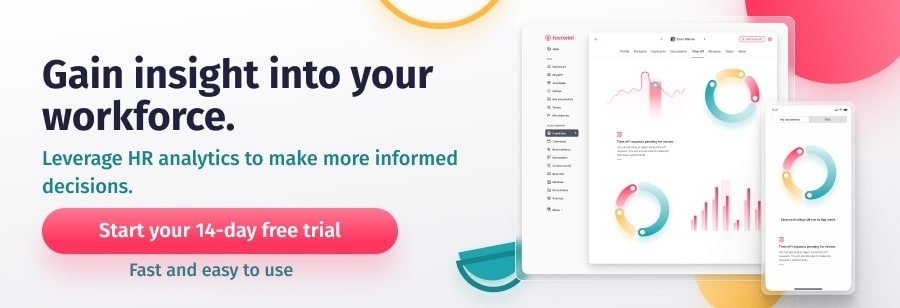When it comes to recruitment, efficiency is key. From looking at the needs of the company to the onboarding of new talent, a hiring dashboard allows HR professionals to have a bird’s-eye-view of the entire process.
The changing events of the past two years have left many HR professionals feeling overwhelmed and burned out. Many are searching for ways to simplify and optimize the process of hiring and managing new talent.
It’s hard to keep track of all of the data involved in acquiring new talent. Rather than trying to keep tabs on information, a hiring dashboard centralizes data, allowing you to make better, more informed hiring decisions.
- What is a hiring dashboard?
- The benefits of a hiring dashboard
- Key recruiting metrics in a hiring dashboard
- Best tools to create a hiring dashboard
What is a hiring dashboard?
Like other kinds of HR dashboards, a hiring or recruiting dashboard is a space used to organize and keep a visual score of HR reports and analytics. Basically, it is a tool that helps HR professionals to see data and gain insight into their growing team.
Within a hiring dashboard, there are HR key performance indicators (KPIs) related to the recruitment and selection process. Using these performance indicators, HR professionals can make better data-driven decisions for their company.
Why have a hiring dashboard?
Being able to see all of the essential metrics at a glance can help to quickly identify problems and trends that occur throughout the hiring process. In a nutshell, a hiring dashboard helps to organize and improve every stage of recruitment. Here are some of the benefits of recruiting dashboards.
Attract qualified talent
Targeting qualified candidates can help employers improve retention and reduce high turnover rates. With a hiring dashboard, recruiters can see which hiring tactics work well. This helps to develop hiring strategies that successfully bring in top talent.
Reduce expenses with a hiring dashboard
Generally speaking, all HR dashboards can help to leverage labor costs and see where extra time and money are spent. Hiring dashboards are no different. With a recruitment dashboard, hiring managers can detect excessive spending and take cost-effective, strategic action.
Reach goals faster with a hiring dashboard
Perhaps an Objective and Key Result (OKR) for your company is to reduce the amount of time spent hiring and onboarding new employees. Having a hiring dashboard means that human resources can reach their goals faster and without struggle.
Ensure a smooth recruitment process
Reputation is powerful, and having a good track record is important for the company’s overall success. Having a smooth recruitment process sends the right message to potential candidates.
To set up a successful hiring dashboard, it’s important to determine which KPIs to include. Let’s take a closer look at key recruitment metrics and how they impact the process of acquiring new talent.
Recruiting metrics to include in your hiring dashboard
When building a dashboard, it’s important to target the specific data that you need to see. As a general rule of thumb, more is less. The metrics used in hr reports and dashboards should help to answer basic questions. To determine which recruitment metrics are the most important, think about the following questions.
How long does it take to hire new employees?
Recruitment metric: Time to hire
This KPI measures the amount of time between the moment of the first contact with a candidate the moment that they accept a position. Like other kinds of workforce analytics, the time to hire can be used to measure the amount of efficiency while moving from point A to point B. In general, the lower the time to hire, the better.
How much does it cost to hire new employees?
Recruitment metric: Cost per hire
The costs of hiring new team members are diverse. There are administrative expenses, compensation for staff involved, job advertisements and interviews, etc. In order to budget for this process, it is important to know exactly how much is needed and keep track of expenses. Careful tracking will help you to see where expenses can be cut.
How long does it take to fill positions?
Recruitment metric: Time to fill
The time to fill is a metric that gives insight into the overall stability of the workforce. This metric can indicate the overall efficiency of the hiring process. However, it should be noted that not all time-to-hire rates are created equal! Often, specialized and executive roles require more time to find the right candidate.
Where are applicants applying?
Recruitment metric: Source of hire
A good question to ask with every new hire is where did they see the job posting? Which job boards have a higher probability of bringing in top talent? This will help recruiters determine where to post job ads and drive more targeted hiring campaigns.
How many candidates accept offers?
Recruitment metric: Offer acceptance rate
Like the candidate satisfaction metric, the OAR reflects how aligned offers are to the needs of prospective hires. Generally, high OARs mean that job specs are what candidates are looking for and the hiring process is running smoothly. IF the OAR is low, it might be time to revisit current trends and take a closer look at your hiring pipeline.

How satisfied are candidates?
Recruitment metric: Candidate Satisfaction Rate
The candidate experience is always a good aspect to keep in mind while hiring new talent. Along with other people analytics, measuring satisfaction can help to improve retention rates and create a healthy work environment. Although you most likely won’t be hiring all candidates that come in contact, the hiring process will give them a lasting impression of your organization and affect your company’s brand image.
How effective is the hiring funnel?
Recruitment metric: Recruitment funnel
How effective is your recruitment process from beginning to end? Is something that can be done to speed up the interview process? To answer these questions, it is important to have an overview of the overall hiring pipeline or recruitment funnel.
Generally, recruitment funnels consist of the number of applications, interviews, assessments, and hires. By tracking the amount of time that candidates spend in each phase of the recruitment process, it can help to see where there are bumps in the road.
More recruitment metrics to consider
Although it is simply impossible to keep track of every single recruitment metric out here, there are a few that should be on your radar. In addition to those previously mentioned, here are some more metrics to account for.
Adverse impact
Adverse impact measures the negative impact that employment practices have on protected groups under Title VII of the Civil Rights Act of 1964. Specifically, practices that exclude employees based on race, skin color, sexual orientation, gender identity, age, disability status, national origin, veteran status, and religion. Hiring managers should be especially careful of adverse impact, as it is most evidently seen in recruitment practices.
To measure adverse impact, recruiters should take into account the four-fifths rule. This rule is approved by the EEOC and will help recruiters to weed out potentially discriminatory practices while hiring. Basically, the rule is a comparison between the rate of selection for protected groups of individuals against the rate of selection of the most-represented group.
Under the four-fifths rule, the selection rate of protected groups should be 80% or more for the selection of the selection rate of the most-represented group. For example, if there are 10% of applicants who identify as female and 16% who identify as male are selected to interview for a position, you would simply divide 10/16 and arrive at the ratio of 62.5%. Since this is less than the minimum of 80%, there would be an adverse impact taking place in the selection process.
Quality of hire
The quality of hire takes into account the employee’s performance throughout their first year on the job. Higher performance scores correspond to better quality hires, while lower scores indicate bad hires. Generally speaking, this metric can help recruiters to see the value that their hires bring to the organization. Although, it is also one of the most difficult metrics to actually pinpoint and accurately track.
Additionally, hiring managers can look at first-year turnover and attrition rates, as well as the hiring manager satisfaction rates to gain insight into the success of a new hire. The quality of hire is also a useful metric to consider when looking at candidate sourcing. By comparing the quality of hire and the source of hire metric, you can see how effective job boards and campaigns were at finding qualified candidates.
New hire attrition
For many hiring managers, the new hire attrition rate is a top indicator of hiring success. Also called new hire turnover, or first-year turnover, this recruitment metric really helps recruiters see whether or not selected candidates were a good fit for the team. Additionally, high new hire attrition rates can indicate problems like inaccurate job descriptions and role expectations.
High turnover rates are never a good sign, and it is important to consider all of the circumstantial factors before jumping to any conclusions. Hiring managers need to discern whether the turnover/attrition was voluntary or involuntary, as the implications can be very different in each situation. Voluntary meaning that the new hire left on their own accord. In the case of involuntary turnover, the new employee was terminated by the employer.
Tools to create the best hiring dashboard
The best way to create a hiring dashboard is with HR software.
With software, creating dashboards and HR reports is easy! Factorial’s software allows you to generate custom dashboards and HR reports in a way that is visual and intuitive.
Using automated HR reports, Human resources can identify workplace gaps, measure hiring expenses, and target successful candidates. Ultimately, ensuring a more effective and streamlined hiring process.




It is really important to take note of the metrics during the hiring process. Well written!